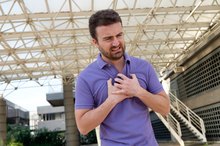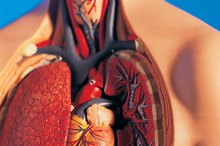Why Does the Right Side of Your Chest Hurt?
Right-sided chest pain can be frightening. **Several important organs, including your lungs, heart and major blood vessels, lie within the chest cavity.
If you are experiencing serious medical symptoms, seek emergency treatment immediately.
** Chest pain on the right can be caused by something as minor as a muscle strain or it could be the sign of a major, life-threatening problem. Knowing symptoms of serious conditions can help you determine when to seek medical attention.
Musculoskeletal or Traumatic Causes
Sometimes right-sided chest pain is due to a minor problem like a side stitch -- a temporary muscle cramp experienced by runners.
But other types of chest pain caused by an injury can be persistent, incredibly painful and possibly very serious. Muscles or ligaments in the chest walI can be strained by improper movement. This pain increases when the area is touched or when the body is moved in certain ways.
Chest wall strain can generally be diagnosed by your doctor performing a physical examination and eliminating other causes. Rest and over-the-counter or prescription medications can help heal the injury and relieve pain.
If trauma to the chest is very forceful or causes a break in the skin, it may fracture a rib or damage organs within the chest cavity. This is a medical emergency.
- Sometimes right-sided chest pain is due to a minor problem like a side stitch -- a temporary muscle cramp experienced by runners.
- If trauma to the chest is very forceful or causes a break in the skin, it may fracture a rib or damage organs within the chest cavity.
Infections
Causes of Burning Pain in the Chest & Back
Learn More
Right-sided chest pain associated with a fever, cough with sputum or shortness of breath may indicate that you have pneumonia on that side. When bacteria, viruses or other microorganisms settle into an area of the lung, they can cause an acute infection with inflammation and pain. **According to Merck Manual, pneumonia affects approximately 2 to 3 million people in the United States every year 5.
** Pneumonia is often diagnosed by abnormalities noted on a chest x-ray. Your doctor will prescribe antibiotics if the pneumonia seems to be caused by a bacteria.
- Right-sided chest pain associated with a fever, cough with sputum or shortness of breath may indicate that you have pneumonia on that side.
Vascular Conditions
A number of major blood vessels, including the aorta and pulmonary arteries, sit within the chest cavity. Pulmonary embolism (PE) occurs when a blood clot lodges in an artery of the lung 2.
It can produce sharp right-sided chest pain if the PE is in the right lung.
**With a PE, your chest pain may worsen when taking deep breaths, and you may also notice shortness of breath or bloody sputum.
A tear of the aorta -- the large artery leading blood from the heart to the rest of the body -- causes sharp, severe chest pain that usually occurs suddenly. It requires immediate medical attention. **
- A number of major blood vessels, including the aorta and pulmonary arteries, sit within the chest cavity.
- With a PE, your chest pain may worsen when taking deep breaths, and you may also notice shortness of breath or bloody sputum.
Other Possibilities
Causes of Pain on the Right Side of the Chest When Breathing
Learn More
There are various other reasons for right-sided chest pain. Lung cancer is a possibility if you have persistent chest pain accompanied by shortness of breath or unintentional weight loss. Another source may be referred pain, which is pain caused a problem in another area of the body. The gallbladder sits directly underneath the right chest, so when it becomes inflamed, the irritation can cause referred pain upward into the right chest. Nausea or vomiting is common with gallbladder problems.
Heart problems, such as a heart attack, may sometimes cause pain in the right chest, even though the heart is located primarily on the left side of the chest. This is most likely if the right side of the heart is affected.
- There are various other reasons for right-sided chest pain.
- Heart problems, such as a heart attack, may sometimes cause pain in the right chest, even though the heart is located primarily on the left side of the chest.
Warnings
Chest pain is a symptom you should never ignore. If right-sided chest pain is severe or worsening or if it was caused by significant trauma, seek immediate medical attention. Also obtain immediate medical care if your pain is accompanied by other symptoms like lightheadedness, dizziness, sweating, fever, shortness of breath or bloody sputum. Persistent pain, even without other symptoms, could indicate a serious problem and should be assessed by your doctor.
Reviewed by Mary D. Daley, MD.
- Chest pain is a symptom you should never ignore.
- Persistent pain, even without other symptoms, could indicate a serious problem and should be assessed by your doctor.
Related Articles
References
- American Family Physician: Pulmonary Embolism Rule-Out Criteria: A Clinical Decision Rule That Works
- Centers for Disease Control and Prevention: Deep Vein Thrombosis (DVT) / Pulmonary Embolism (PE) — Blood Clot Forming in a Vein
- Merck Manual Professional Version: Acute Coronary Syndromes (ACS)
- American Heart Association: Understand Your Risk of Heart Attack
- Merck Manual Professional Version: Overview of Pneumonia
- American Family Physician: Diagnosis and Management of Spontaneous Pneumothorax
- American Family Physician: Costochondritis: Diagnosis and Treatment
- Aroesty, J., and J. Kannam. Patient education: Chest pain (Beyond the Basics). UpToDate. Updated 08/27/18.
- Roongruangchai J, Narongsak W, Plakornkul V, Viravud Y, Sripaoraya K, Roongruangchai K. Situs inversus totalis and ultrastructure of respiratory cilia: report of a cadaveric case. J Med Assoc Thai. 2012;95(1):132-8.
- Khandaker MH, Espinosa RE, Nishimura RA, et al. Pericardial disease: diagnosis and management. Mayo Clin Proc. 2010;85(6):572-93. doi:10.4065/mcp.2010.0046
- Lavorini F, Di bello V, De rimini ML, et al. Diagnosis and treatment of pulmonary embolism: a multidisciplinary approach. Multidiscip Respir Med. 2013;8(1):75. doi:10.1186/2049-6958-8-75
- Zarogoulidis P, Kioumis I, Pitsiou G, et al. Pneumothorax: from definition to diagnosis and treatment. J Thorac Dis. 2014;6(Suppl 4):S372-6. doi:10.3978/j.issn.2072-1439.2014.09.24
- Rao SS. Diagnosis and management of esophageal chest pain. Gastroenterol Hepatol (N Y). 2011;7(1):50-2.
- Proulx AM, Zryd TW. Costochondritis: diagnosis and treatment. Am Fam Physician. 2009;80(6):617-20.
- Huffman JC, Pollack MH, Stern TA. Panic Disorder and Chest Pain: Mechanisms, Morbidity, and Management. Prim Care Companion J Clin Psychiatry. 2002;4(2):54-62.
- Aroesty, J., and J. Kannam. Patient education: Chest pain (Beyond the Basics). Updated 08/27/18.
Resources
Writer Bio
A graduate of the Indiana University School of Medicine, Meeta Shah is a board certified-emergency medicine physician with 10 years of clinical experience. After years of countless patient interactions and treating various conditions, she has a wealth of experience and knowledge to share with readers.






